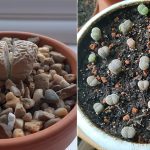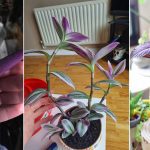These pretty cactuses that bloom flowers are perfect for the finicky gardeners who want a colorful display with minimal effort!
Cacti are famed for their low-maintenance nature, thanks to their ability to store water for extended periods. What makes them even more special is their occasional burst of colorful flowers, which add stunning visual appeal to any garden setting!
Cactuses that Bloom Flowers
1. Queen of the Night
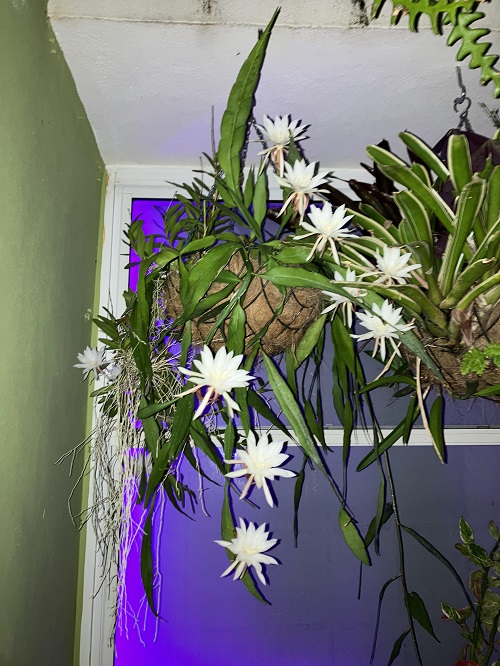
Botanical Name: Epiphyllum oxypetalum
Aptly named The Queen of the Night, it features nocturnal flowers growing on flattened stems that are large, fragrant, and palm-shaped. To describe them, one must say that the flowers look like a mix of a tulip and a rose.
2. Golden Barrel Cactus
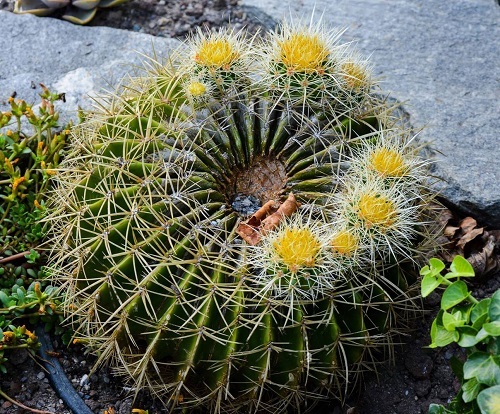
Botanical Name: Echinocactus grusonii
The golden barrel cactus, which originates from Mexico, is a slow-growing cactus with bright yellow blooms, each 5 cm wide, that stands out on its barrel-shaped stem, which showcases prominent ribs. The body of the cactus is adorned with areoles complete with bright golden spines. These vibrant flowers appear during late spring and early summer on mature plants with enough sun exposure.
3. Christmas Cactus
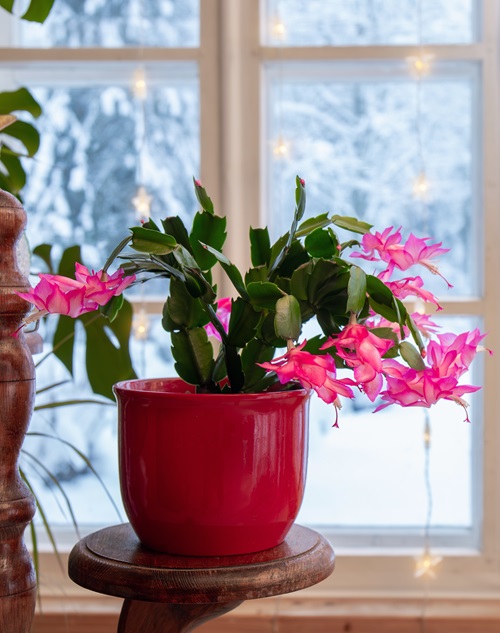
Botanical Name: Schlumbergera spp.
Hailing from Brazil, the Christmas Cactus features flat stems with rounded edges and becomes particularly festive in December thanks to its cascading, tube-like flowers. This cactus is not only easy to care for but also beautifies any space with its vibrant blooms, available in shades of red, pink, or white.
4. Saguaro Cactus
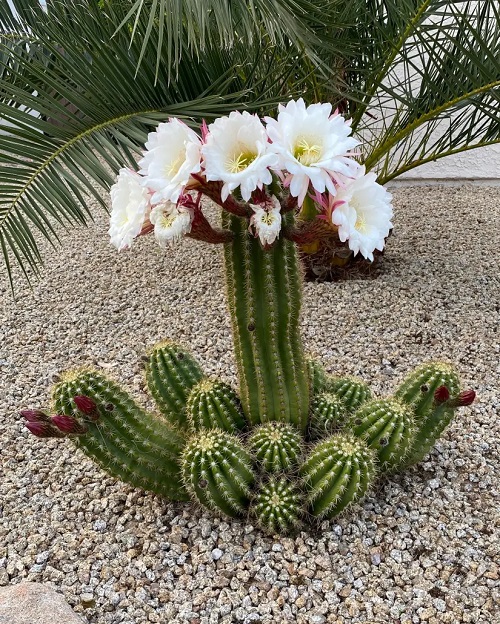
Botanical Name: Carnegiea gigantea
The famous Saguaro Cactus, found in the Sonoran Desert, displays creamy-white flowers in late spring and early summer near the tops of its columnar stems and also on the upward-reaching arms. Though these flowers are not very fragrant, they do emit a strong smell like that of overripe melons.
5. Fishhook Cactus
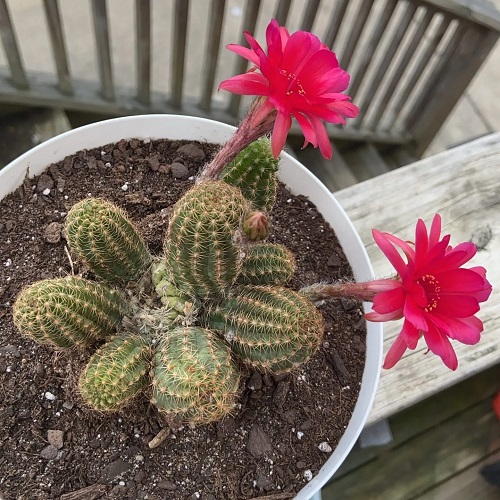
Botanical Name: Mammillaria spp.
With its small size, curved, hooked central spine, and large, ribbed, “barrel-shaped” body, the Fishhook Cactus surprises with vibrant flowers in shades of bright orange and yellow that appear during the months of September and October. These flowers appear at the very top of the cactus, and another unique part about this cactus is that it produces edible, yellow pineapple-shaped fruits.
6. Ladyfinger Cactus
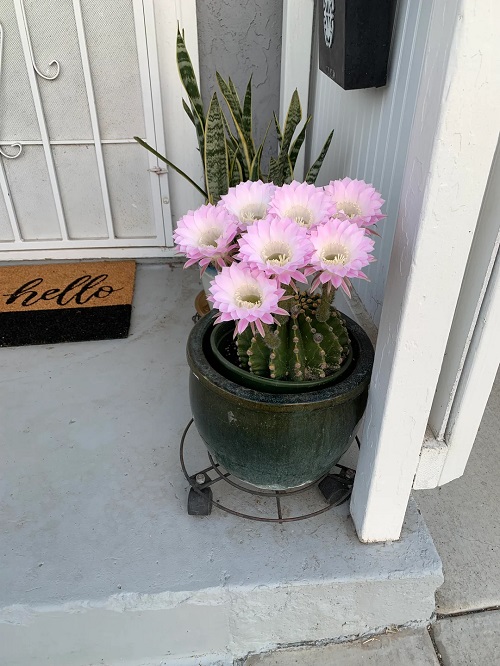
Botanical Name: Mammillaria elongata
The Ladyfinger Cactus is aptly named for its elongated and cylindrical shape, resembling slender fingers, which are typically yellow and sometimes even brown, growing in clusters, forming dense mounds of small cylindrical stems. This cactus produces vibrant flowers, usually in shades of subtle yellow or white during the spring, arising on top of the stems.
7. Bishop’s Cap Cactus
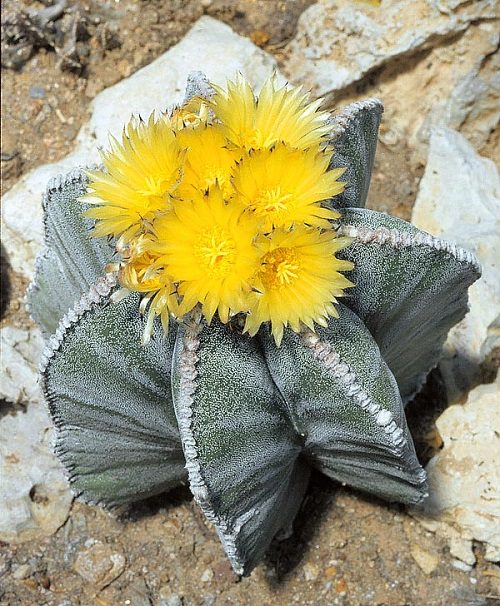
Botanical Name: Astrophytum myriostigma
Native to Mexico, this is yet another cactus plant that has been appropriately named thanks to its appearance, which is exactly like a special kind of hat. Specifically, the plant has a globose, which becomes cylindroid as it gains more ribs and develops fuzzy spots on its surface. When it blooms, it shows off big, bright, fragrant yellow flowers that bloom during early spring or summer, especially during the day.
8. Hedgehog Cactus
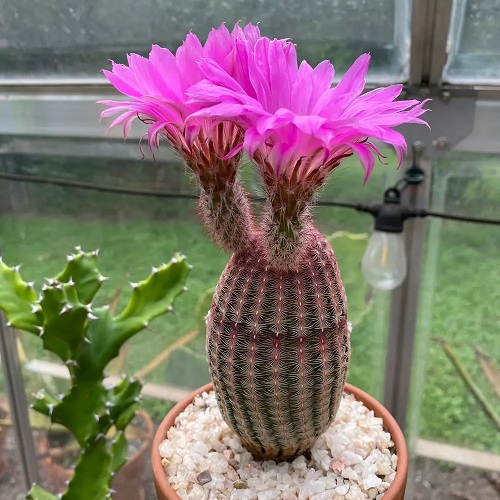
Botanical Name: Echinocereus spp.
These cacti are found in various habitats across North and South America. With a low, rounded shape and spines resembling hedgehog quills, they adapt well to arid environments. Hedgehog cacti often produce large, colorful flowers in red, pink, or yellow during the spring or summer.
9. Organ Pipe Cactus
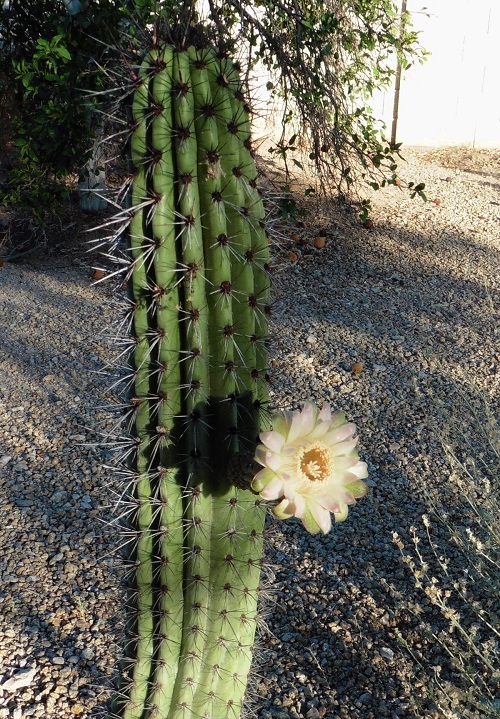
Botanical Name: Stenocereus thurberi
A notable cactus species native to the Sonoran Desert in North America, the Organ Pipe Cactus grows in clusters, forming a multi-stemmed structure with branches extending from a central base. It produces nocturnal, funnel-shaped flowers that are only three inches wide and pinkish-red with white edges. They remain closed during the day and open only after sunset.
After flowering, the plant develops edible fruit that is large and round and eventually loses its spines as it ripens.
10. Old Man Cactus
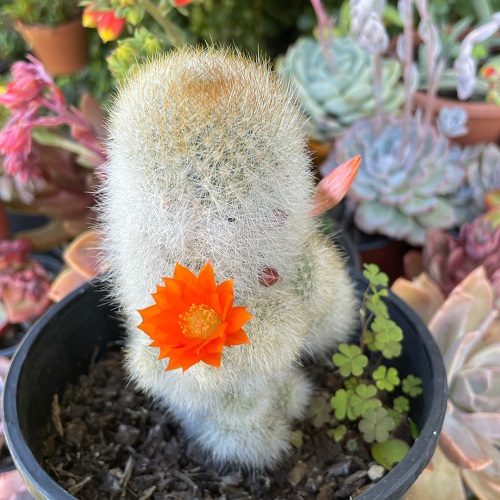
Botanical Name: Cephalocereus senilis
Native to Mexico, the Old Man Cactus is named so because of its unique appearance. Its surface features unique white hairs resembling the long, shaggy hair of an old man. The cactus produces solitary, nocturnal, funnel-shaped flowers that are 2 to 3.5 inches long and 3 inches wide, showcasing yellowish-pink or rose colorations.
11. Arizona Rainbow Cactus
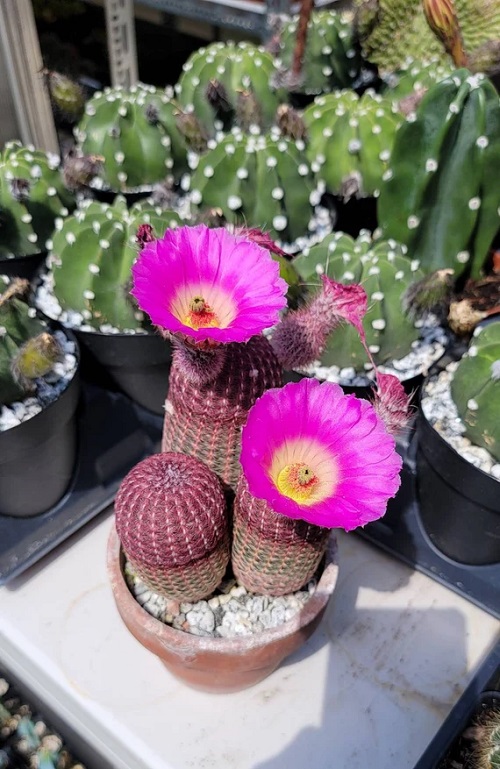
Botanical Name: Echinocereus rigidissimus var. rubrispinus,
The Arizona Rainbow Cactus is a unique cactus found in the arid regions of Arizona and nearby areas. You will know that the plant is healthy when it is funnel-shaped and vibrantly colored, ranging from red to white. If you take good care of the plant, it will reward you with beautiful magenta blooms!
12. Elephant Tooth Cactus
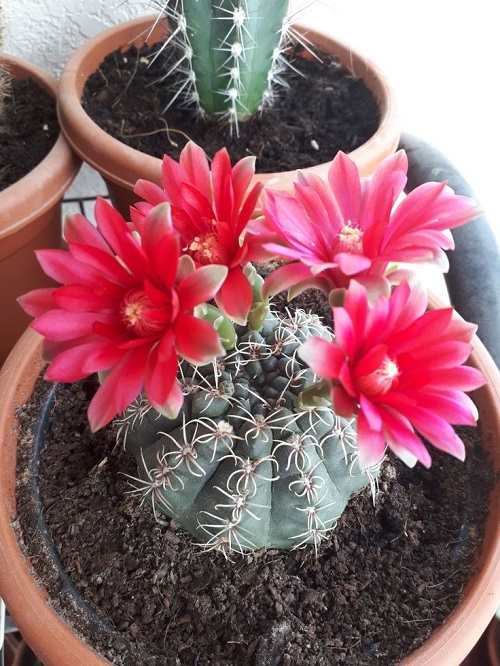
Botanical Name: Coryphantha elephantidens
An excellent cactus plant for growing and propagation, this small solitary cactus is named so for the shape and arrangement of its tubercles, which resemble the molars of an elephant. During the flowering season, typically in late spring to early summer, the Elephant Tooth Cactus produces bright pink to sometimes even yellow colors.
13. Star Cactus
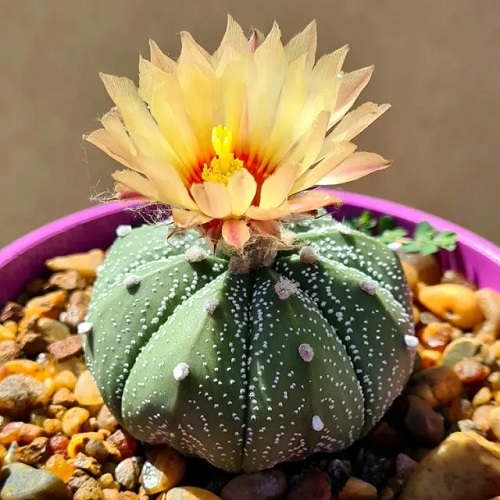
Botanical Name: Astrophytum asterias
The Star Cactus is a small, round cactus from Mexico known for its unique appearance. Its ribbed structure resembles a star, and it blooms with bright yellow exotic-looking flowers in spring and early summer, making it even more attractive. However, be careful even growing them indoors, especially without ventilation, because the inside of the flowers smells like a dead animal if you stick your nose in one.
14. Blue Columnar Cactus
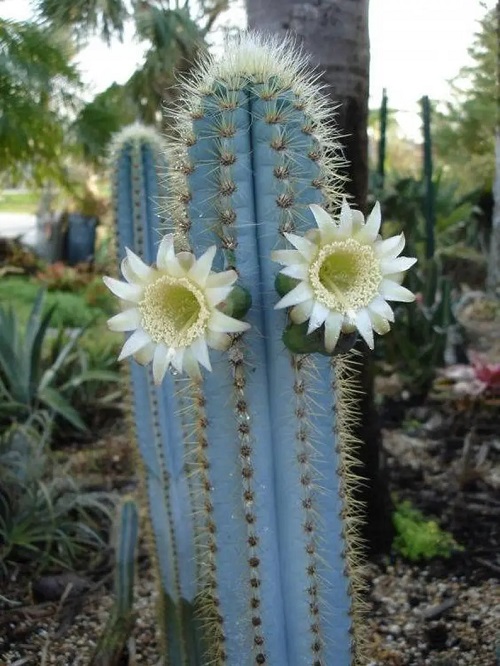
Botanical Name: Pilosocereus pachycladus
Native to various regions in South America, the Blue Columnar Cactus obtains its distinctive blue-green color from a protective waxy coating that shields the cactus from intense sunlight and reduces water loss. This stunning color combination in its spines makes for a great interior design choice if you want to be creative with the color palette.
During the flowering season, mature specimens produce beautiful white, funnel-shaped flowers that can vary in color. They often appear in shades of white or cream and bloom at night.
15. Devil’s Tongue Cactus

Botanical Name: Ferocactus latispinus
The Devil’s Tongue Cactus earns its name from its long, hooked yellow-pink spines, which give it a distinctive and somewhat menacing appearance. During the blooming season, typically in late spring to early summer, this cactus produces vibrant yellow or orange flowers near the apex of the plant.
16. Paper Spine Cactus
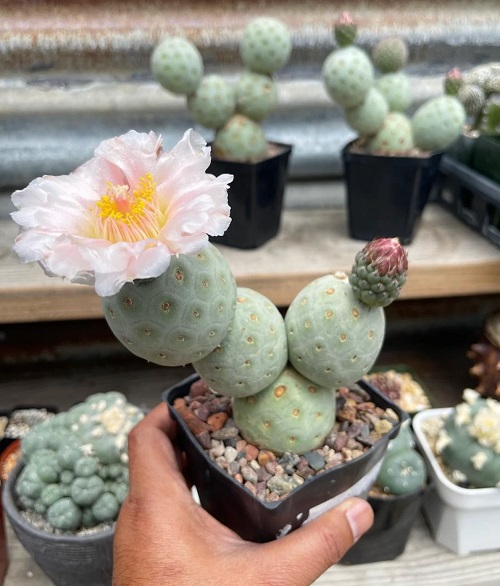
Botanical Name: Tephrocactus articulatus
Native to South America, particularly Argentina, The Paper Spine Cactus is a cactus species with distinctive flattened and segmented stems. This cactus is a piece of work to get to bloom indoors, but when it does bloom, it sends up large, white flowers that beautifully contrast its purplish-green undertones.
17. Gold Lace Cactus
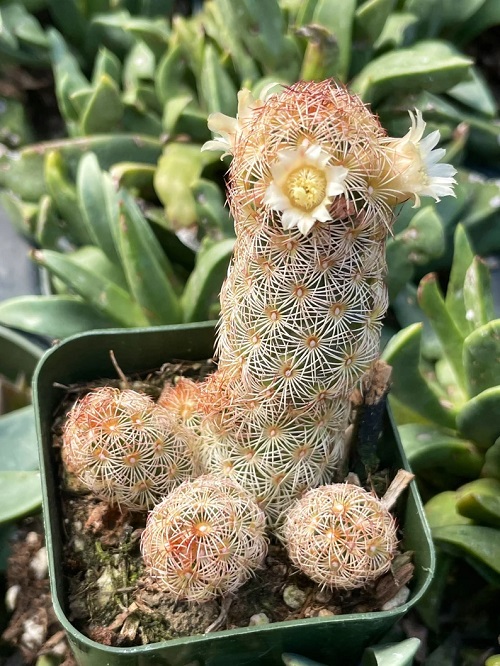
Botanical Name: Mammillaria elongata
The Gold Lace Cactus has an appearance that boasts a group of cylindrical stems with yellow-brown spines, resulting in an overall golden brown appearance. During spring flowering season, you will find this beginner-friendly cactus blooming with beautiful pink-yellow flowers.
18. Lobivia Cactus
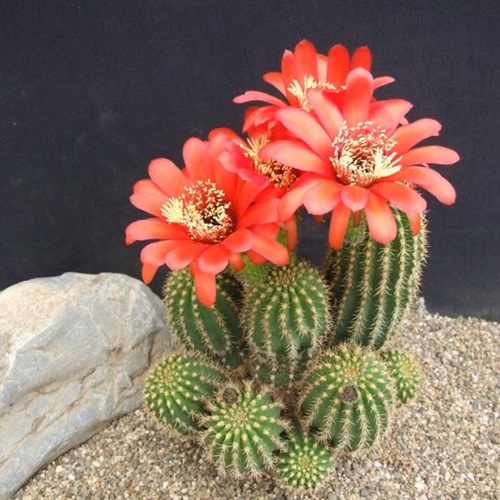
Botanical Name: Lobivia arachnacantha
Native to South America, especially the Andes region, Lobivia cacti are small and often form clusters of colorful, spiky, round stems. These cacti have large, stunning flowers in red, pink, orange, yellow, or white. The flowers bloom in the spring and summer, and you can enjoy their beauty for several days!
19. Emory’s Barrel Cactus
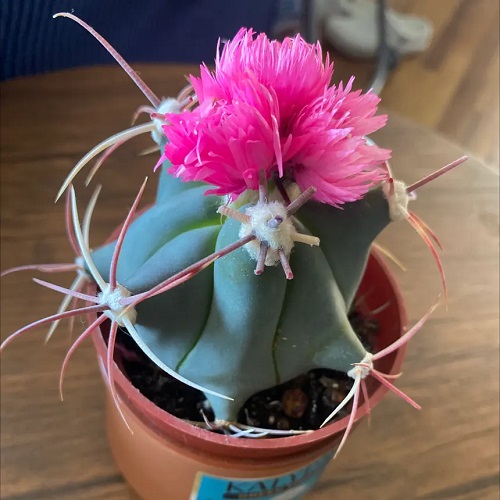
Botanical Name: Ferocactus emoryi
Thriving in arid conditions, Emory’s Barrel Cactus is known for its stout and barrel-shaped or column-shaped body, marked by well-defined ribs and robust spines. During late spring to early summer, this cactus produces vibrant yellow, orange, and red flowers near the crown, which reach lengths of up to 7.5 centimeters and are 5 to 7 centimeters wide.
20. Red Torch Cactus
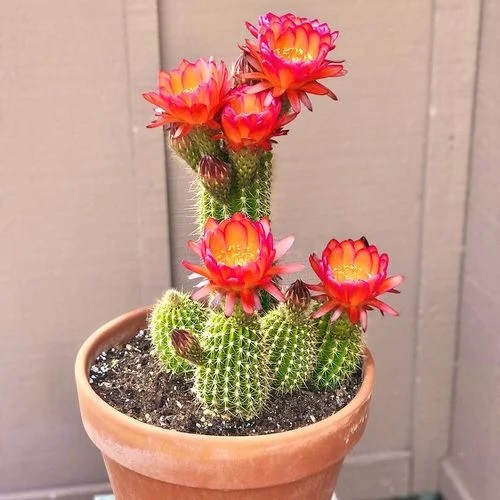
Botanical Name: Echinopsis huascha
The Torch Cactus is notable for its huge display of dramatic red-colored flowers that open in late spring. Adult Torch Cactus flowers can often produce displays of flowers that cover the top of the plant and can look like a carpet of red flowers from above.
21. Pincushion Cactus

Botanical Name: Mammillaria crinita
Rose Pincushion Cactus has 4 (the upper 3 straight, the lowest hooked) reddish central spines and clusters of soft, hair-like 15 – 18, white radial spines. The flowers are pale pinkish violet or purple in color, with yellowish stigmas. Rings of flowers are present most of the year.
22. Ariocarpus Cactus

Botanical Name: Ariocarpus fissuratus
The large, variegated flowers, which appear on mature plants from September through late autumn, are large and vary in color from white to magenta and yellow. The fruits ripen in the following spring. Ariocarpus is widespread in the United States (Texas) and Mexico. They are a mixture exclusively of minerals of lapillus and pumice or natural soils.
23. Night Blooming Cactus
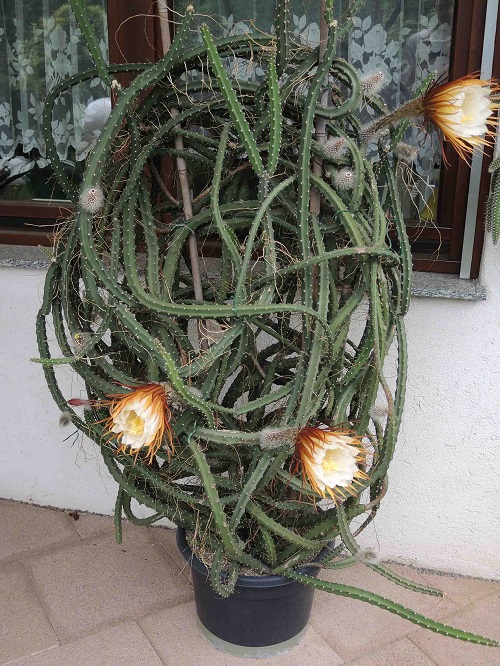
Botanical Name: Selenicereus grandiflorus
The night blooming flowers of Selenicereus grandiflorus are large, about 15 inches wide, white, and have a delicate appearance. The white flowers of tree species only last for one night in the spring, but they are definitely worth the wait.
24. Rebutia Cactus
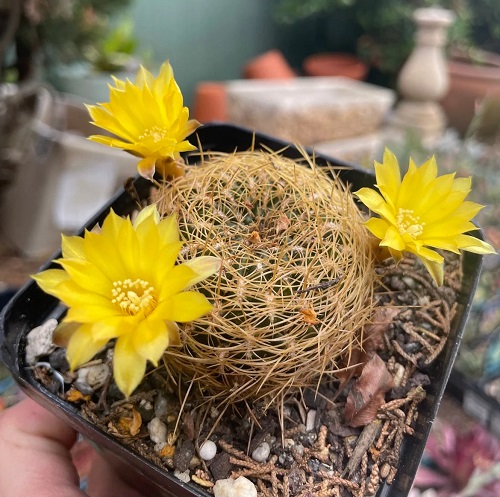
Botanical Name: Rebutia spp.
has very nice red flowers. This plant flowers consistently and prolifically. The “normal” and more frequently seen form has bright orange-red flowers, but color variations range from dark red to orange and yellow to pure white. Cultivation: Full sun to light shade.
25. Parodia Warasii
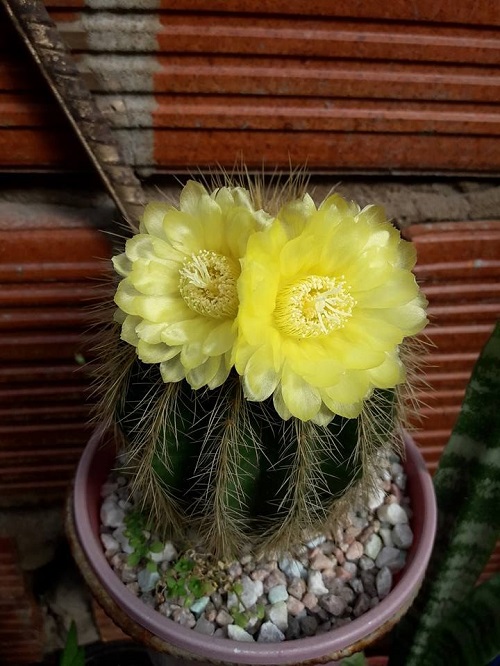
Botanical Name: Parodia warasii
Typically, they are globose, though some elongate into short cylinders over time. The flowers emerge near the plant’s apex and are often very showy. Yellow is the most common flower color, though some species have flowers in other colors (orange, pink, red, or green).
26. Peruvian Old Lady Cactus
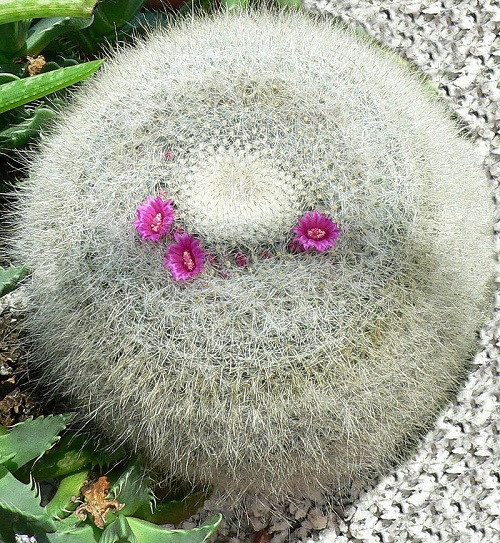
Botanical Name: Espostoa melanostele
It is very rare to see this species in bloom, but its 2.0″ white flowers are specially adapted to close in rainstorms and reopen when dry. In the wild, it can reach over 6.0′ tall at maturity but stays small, potted on a window sill.
27. Turk’s Cap Cactus
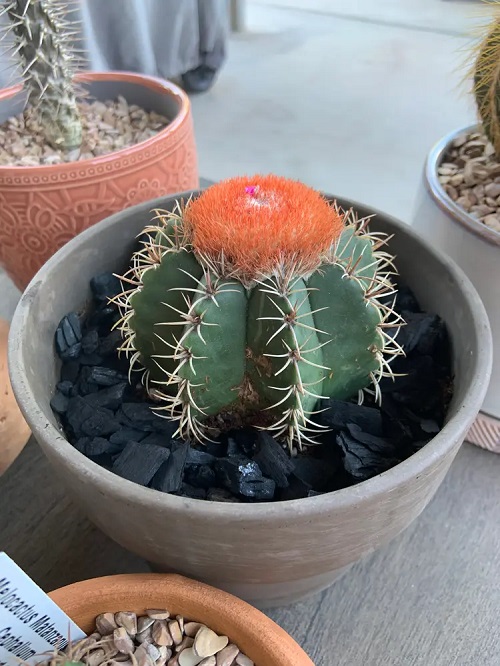
Botanical Name: Melocactus
Hailing from Brazil, this pretty cactus sports a globular, noticeably ribbed, frosty blue body that’s protected by variably colored spines — silvery white to reddish brown. When the cactus reaches a certain age, fetching pink flowers emerge from its cephalium.
28. Ric Rac Orchid Cactus
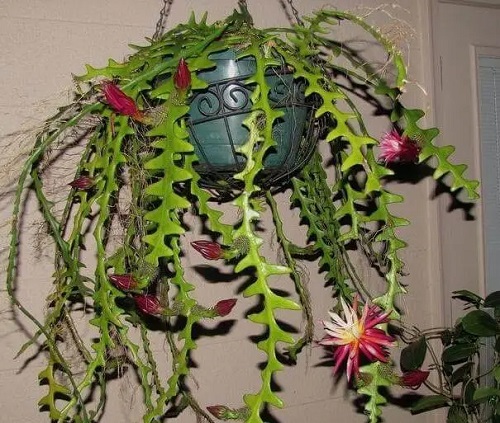
Botanical Name: Selenicereus anthonyanus
The pure white blooms, with orange-bronze sepals and petals, open over many weeks. This easy-to-grow, fragrant plant makes an excellent subject for hanging containers. In late winter/early spring, watering begins at this time.
29. Button Cactus

Botanical Name: Epithelantha micromeris
The flowers of this plant are the smallest of any cactus species in the Trans-Pecos. They are tiny and pinkish with red to brownish mid stripes, usually quite distinct. Filaments are red to yellow, anthers pink to creamy yellow, and stigmas white.
30. Brain Cactus
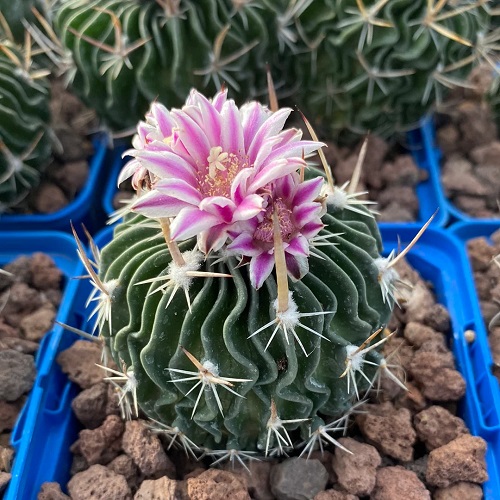
Botanical Name: Stenocactus crispatus
This small to medium-sized cactus with a globular or cylindrical shape produces vibrant flowers in various colors, adding to its visual appeal. It can be a great addition to succulent gardens, rock gardens, or as a potted plant.
31. Peanut Cactus
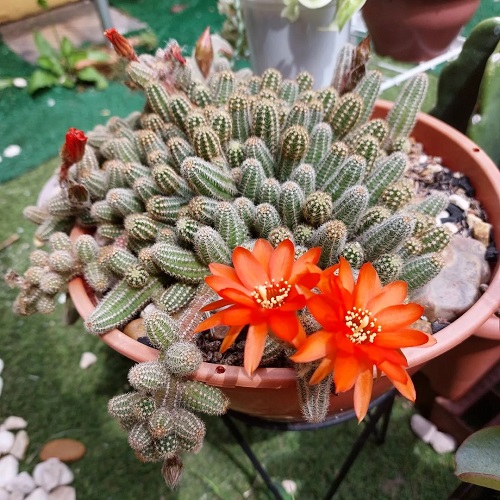
Botanical Name: Echinopsis chamaecereus
The Peanut Cactus is a small cactus with cylindrical stems that exhibit a segmented jointed appearance resembling peanuts. The trailing green stems make it an attractive hanging or trailing plant with vibrant and showy flowers, typically in shades of red, orange, or pink. The Peanut Cactus is a popular choice for succulent gardens, hanging baskets, or as a ground cover in rock gardens.
32. Triangle Cactus
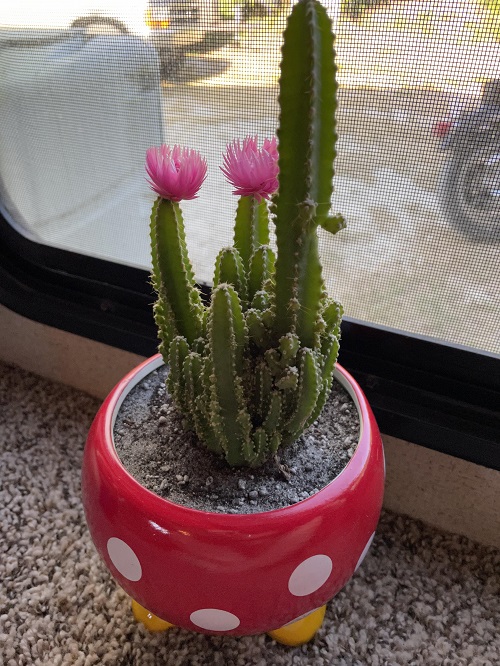
Botanical Name: Acanthocereus tetragonus
This cactus is recognized for its three—or four-sided stems, which give it a triangular or square-like appearance. It produces large, nocturnal flowers, which are typically white and have a pleasant fragrance. The flowers open at night and close by morning.
33. Golden Ball Cactus

Botanical Name: Notocactus leninghausii
Native to Uruguay and southern Brazil, the golden ball cactus features a spherical or globular shape, which resembles a perfect ball. This cactus produces vibrant yellow flowers that emerge from the apex of the plant, creating a lovely contrast against its golden-green body.
34. Fire Barrel Cactus
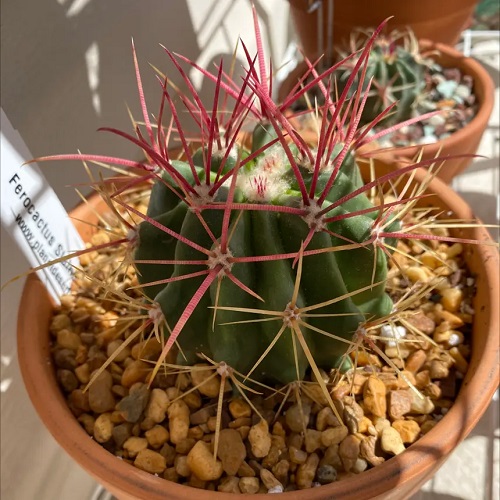
Botanical Name: Ferocactus pilosus
The Fire Barrel Cactus earns its name by displaying vibrant red, orange, or yellow flowers that blossom on its barrel-shaped body. Originating from Mexico, this cactus flourishes in bright sunlight and soil that drains well, making it a sturdy option for dry gardens.
35. Moon Cactus
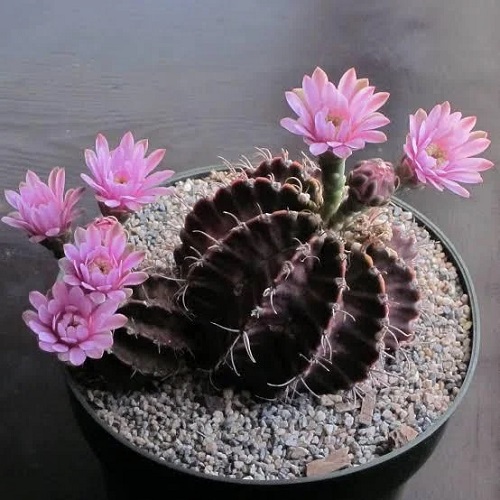
Botanical Name: Gymnocalycium mihanovichii
Known for its unique appearance, the Moon Cactus is a small colorful cactus with a flattened, disk-like shape. It produces vibrant flowers in shades of pink, red, or orange, bringing a burst of color to indoor gardens and containers.
36. Pink Easter Cactus
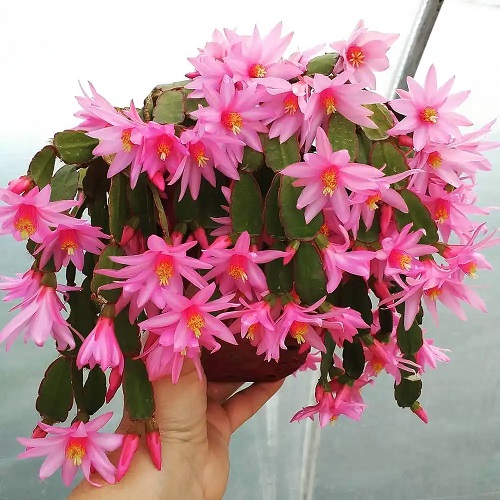
Botanical Name: Hatiora gaertneri
The Pink Easter Cactus, originally from Brazil, features lovely pink flowers that drape along its hanging stems. Its distinctive trailing nature makes it a common pick for hanging baskets, bringing a touch of grace to indoor areas.
37. Blue Barrel Cactus
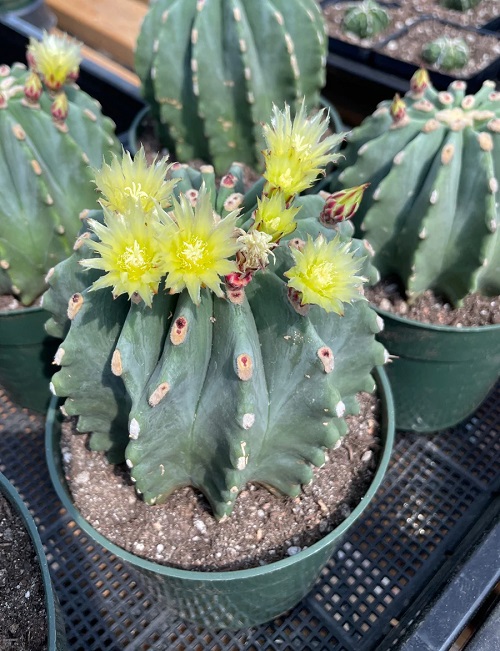
Botanical Name: Ferocactus glaucescens
With its striking blue-green hue, the Blue Barrel Cactus is a visually appealing species. Native to Mexico, it displays vibrant yellow flowers that add a burst of color to its cylindrical body. This cactus thrives in arid conditions and is suitable for xeriscaping.
38. Easter Lily Cactus
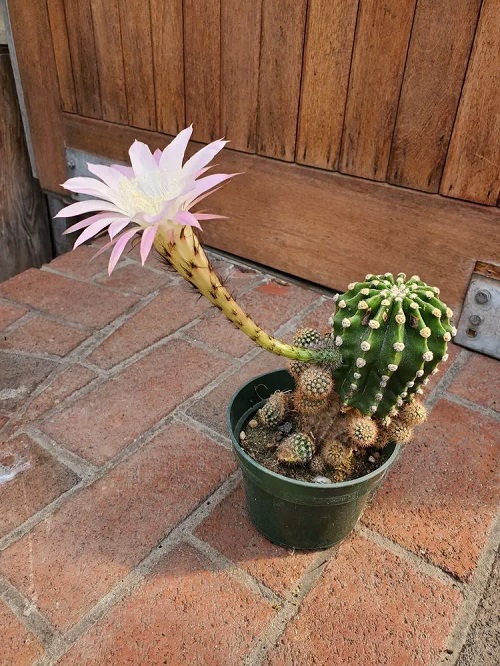
Botanical Name: Echinopsis oxygona
The Easter Lily Cactus, with its long slender stems, produces large trumpet-shaped flowers that resemble Easter lilies. Native to South America, it blooms in various colors, including white, pink, and yellow.
39. Lemon Ball Cactus

Botanical Name: Notocactus magnificus
The Lemon Ball Cactus is a unique and captivating plant shaped like a small, round ball with bright yellow spines. Native to South America, it produces lemon-yellow flowers that complement its spiky appearance.





